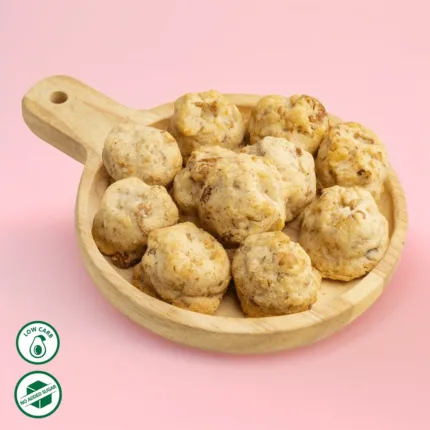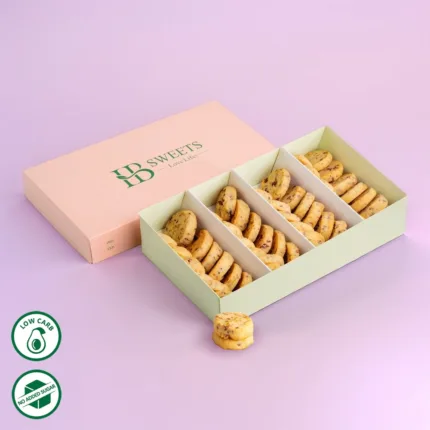The Quest for the Perfect Healthy Vanilla Cookie: A Baker’s Journey
For many, the ideal cookie conjures up images of warm, pillowy dough yielding to a gentle bite, revealing a symphony of soft and chewy textures. But when it comes to healthy alternatives, the quest for this delightful balance can feel like searching for the Holy Grail. Fear not, fellow cookie connoisseurs! This guide will equip you with the knowledge and a winning recipe to craft the perfect healthy, soft, and chewy vanilla cookies.
Understanding the Science Behind Soft and Chewy Cookies
Before we delve into the recipe, let’s explore the science behind achieving that coveted soft and chewy texture. Here are the key players:
- Flour: All-purpose flour is the foundation, but its protein content significantly impacts the final texture. Gluten, a protein network formed when flour hydrates, contributes to chewiness. However, too much gluten development can lead to tough cookies.
- Fats: Butter is a classic choice, adding richness and flavor. The creaming process incorporates air, which expands during baking, contributing to a lighter texture.
- Sugars: A combination of granulated and brown sugar is ideal. Granulated sugar provides sweetness and structure, while brown sugar adds moisture and chewiness due to its molasses content.
- Eggs: They bind ingredients and contribute to leavening (rising) due to trapped air.
- Leavening Agents: Baking soda and baking powder are responsible for the rise. Baking soda reacts with acidic ingredients like brown sugar, releasing carbon dioxide gas. Baking powder contains an acid component, making it double-acting, creating lift during mixing and baking.
Healthy Swaps for Soft and Chewy Goodness
Now, let’s address the “healthy” aspect. Here are some clever swaps you can make without compromising the soft and chewy texture:
- Flour: Whole wheat pastry flour offers a slight boost of fiber while retaining chewiness. You can even try a combination of all-purpose and whole wheat flour.
- Fats: Unsalted butter is the gold standard, but swapping half with applesauce reduces fat content without sacrificing moisture. Coconut oil is another option, adding a subtle coconut flavor.
- Sugars: Honey or maple syrup can replace some of the granulated sugar, providing a touch of natural sweetness and moisture. However, reduce the liquid content in the recipe to compensate for the added moisture.
- Sweeteners: Experiment with sugar substitutes like erythritol or monk fruit if you need to strictly limit sugar intake. Be mindful that these alternatives may affect texture slightly, so start with a smaller amount and adjust to your taste.
The Winning Recipe: Healthy Soft and Chewy Vanilla Cookies
Here’s the culmination of our exploration – a recipe that delivers on both health and taste:
Ingredients:
- 1 1/2 cups all-purpose flour
- 1/2 cup whole wheat pastry flour
- 1 teaspoon baking soda
- 1/2 teaspoon salt
- 1/2 cup unsalted butter, softened
- 1/2 cup applesauce, unsweetened
- 1/2 cup granulated sugar
- 1/4 cup packed light brown sugar
- 1 large egg
- 1 teaspoon pure vanilla extract
- 1/2 cup chopped nuts or chocolate chips (optional)
Instructions:
- Preheat oven to 350°F (175°C) and line baking sheets with parchment paper.
- In a medium bowl, whisk together flours, baking soda, and salt.
- In a large bowl, cream together softened butter and applesauce until light and fluffy.
- Gradually add granulated and brown sugars, beating until well combined.
- Beat in the egg and vanilla extract until fully incorporated.
- Gradually add the dry ingredients to the wet ingredients, mixing until just combined. Do not overmix.
- Fold in chopped nuts or chocolate chips, if using.
- Using a cookie scoop or spoon, portion dough onto prepared baking sheets, leaving space for spreading.
- Bake for 10-12 minutes, or until edges are golden brown and centers are slightly soft.
- Let cookies cool on baking sheets for a few minutes before transferring to a wire rack to cool completely.
Tips for Success
- Measure accurately: Using accurate measurements is crucial for achieving the desired texture. Invest in measuring cups and spoons.
- Creaming is key: Proper creaming of butter and sugars incorporates air, leading to a lighter and airier cookie. Aim for a light and fluffy consistency.
- Don’t overmix: Once the dry ingredients are incorporated, stop mixing. Overmixing develops gluten, resulting in tough cookies.
- Chill the dough (optional): Chilling the dough allows the flavors to meld and helps prevent excessive spreading during baking. Wrap the dough in plastic wrap and refrigerate for at least 30 minutes or up to overnight.
- Bake for just the right time: Resist the urge to overbake. Cookies continue to firm up as they cool. Slightly underbaked centers translate to a chewier texture.
- Use baking mats: Silicone baking mats distribute heat evenly and prevent sticking, promoting consistent baking and easier removal.
Flavor and Fun Variations
This recipe serves as a springboard for your creativity. Here are some ideas to personalize your healthy soft and chewy vanilla cookies:
- Spice it up: Add a teaspoon of ground cinnamon, nutmeg, or ginger for a warm, festive touch.
- Embrace the citrus: Zest of lemon, orange, or lime adds a refreshing brightness.
- Chocolate decadence: Replace half the all-purpose flour with cocoa powder for a rich chocolate cookie base.
- Salty-sweet twist: Sprinkle a pinch of sea salt over the dough balls before baking for a delightful sweet and salty contrast.
- Dried fruit delight: Incorporate chopped dried fruits like cranberries, raisins, or cherries for a chewy and fruity twist.
Beyond the Cookies: Storage and Shelf Life
Once your masterpiece is baked and cooled, store the cookies in an airtight container at room temperature for up to 3 days. For longer storage, transfer them to a freezer-safe container and freeze for up to 3 months.
The Joy of Baking Healthy and Delicious
With this knowledge and recipe in hand, you can embark on a delightful journey of baking healthy, soft, and chewy vanilla cookies. Remember, baking is an art form – experiment with different variations, have fun, and most importantly, savor the satisfaction of creating a delicious and guilt-free treat!
Troubleshooting Common Cookie Conundrums
Even the most seasoned bakers encounter occasional mishaps. Here’s a guide to troubleshoot some common problems you might face while crafting your healthy soft and chewy vanilla cookies:
- Cookies spread too thin:
- Cause:
- Overcreaming butter and sugars incorporates too much air, leading to excessive spreading.
- Incorrect flour measurement (too little) can also be a culprit.
- Solutions:
- Cream butter and sugars just until light and fluffy.
- Measure flour accurately using the spoon and sweep method (filling the measuring cup with a spoon and leveling off excess with a knife).
- Chilling the dough allows the fat to solidify slightly, preventing excessive spreading.
- Cause:
- Cookies are too tough:
- Cause:
- Overmixing the dough develops gluten, leading to a tough texture.
- Using too much flour can have the same effect.
- Solutions:
- Mix the dough just until the dry ingredients are incorporated. Resist the urge to overmix.
- Measure flour accurately and avoid adding extra flour unless absolutely necessary.
- Cause:
- Cookies are too cakey:
- Cause:
- Not enough creaming of butter and sugars can result in a cakey texture.
- Leavening agent issues (not enough or expired) can also contribute to this.
- Solutions:
- Ensure proper creaming of butter and sugars for a light and fluffy consistency.
- Double-check the expiration date of your baking soda and baking powder and replace them if necessary.
- Cause:
- Cookies burn easily:
- Cause:
- Oven temperature might be too high.
- Using dark baking sheets can also contribute to faster burning.
- Solutions:
- Double-check your oven temperature and adjust accordingly.
- Consider using light-colored baking sheets or parchment paper to prevent burning.
- Cause:
- Cookies turn out flat:
- Cause:
- Not enough creaming of butter and sugars can lead to flat cookies.
- Leavening agent issues might also be at play.
- Solutions:
- Cream butter and sugars properly to incorporate air for lift.
- Ensure you’re using the correct amount of fresh baking soda and baking powder.
- Cause:
Beyond the Recipe: Essential Baking Tools
While the recipe is the foundation, having the right tools can elevate your baking experience. Here are some essentials for creating perfect healthy cookies:
- Mixing bowls: Invest in a set of nesting bowls in different sizes for mixing dry and wet ingredients.
- Electric mixer: A hand mixer or stand mixer makes creaming butter and sugars a breeze, ensuring a lighter and airier texture.
- Rubber spatula: This versatile tool helps scrape down the sides of the bowl and ensures even mixing.
- Measuring cups and spoons: Accurate measurement is crucial for consistent results. Invest in a good set of measuring cups and spoons.
- Baking sheets: Look for heavy-duty baking sheets that distribute heat evenly. Silicone baking mats are also a great option for preventing sticking.
- Cooling rack: A wire rack allows air to circulate around the cookies, promoting even cooling and preventing them from becoming soggy on the bottom.
- Cookie scoop: A cookie scoop ensures uniform cookie size and prevents uneven baking.
The Final Bite: A Celebration of Soft and Chewy Goodness
With the knowledge gleaned from this comprehensive guide, you’re well-equipped to embark on your journey to baking the perfect healthy, soft, and chewy vanilla cookies. Remember, baking is a process of exploration and discovery. Don’t be afraid to experiment with different flavors and techniques. Embrace the joy of creating delicious homemade treats that are kind to your body and soul. So, preheat your oven, gather your ingredients, and get ready to celebrate the delightful world of soft and chewy vanilla cookies!
-
 Mix Box79.00 AED
Mix Box79.00 AED -
 Fig Tree Cookie49.00 AED
Fig Tree Cookie49.00 AED -
 Green Life Vegan Cookie21.00 AED
Green Life Vegan Cookie21.00 AED -
 Green Life Vegan Cookie Box39.00 AED
Green Life Vegan Cookie Box39.00 AED -
 Gym Buddy Protein Cookie33.00 AED
Gym Buddy Protein Cookie33.00 AED -
 Coin Cookie Box99.00 AED
Coin Cookie Box99.00 AED







